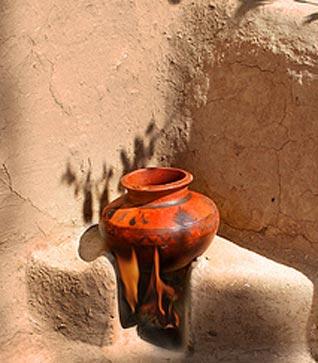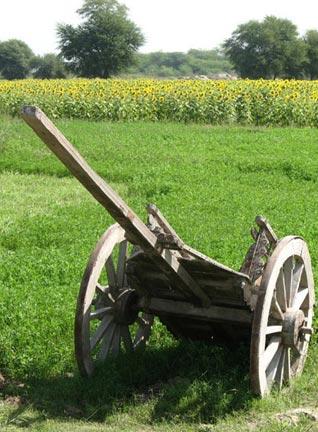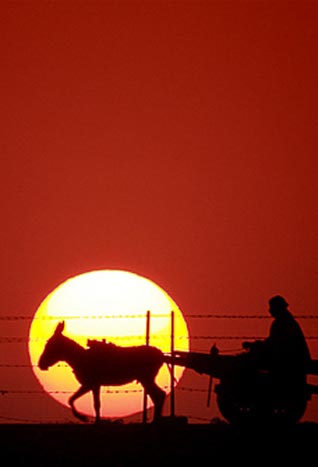Travel
The Old Rural Punjab: Alive and Well Across The Border
by SUNIL SETHI
A lightning strike by Pakistan International Airlines having delayed our plans for our return to Delhi, we found ourselves with a few extra days in Lahore, awaiting our air exit permits to be converted for the overland crossing at Wagah.
Our friend, Jugnu Mohsin, the Cambridge-educated lawyer who is also a leading newspaper publisher and editor, suggested we take a day off to visit her ancestral village about a 100 km southwest of the city on the Multan road. I leapt at the opportunity, for it had been many years since I took a turn in the countryside of West Punjab, now in Pakistan.
At first, everything looked utterly familiar: the same flat fertile landscape with fields of ripening wheat and sugarcane flecked yellow, here and there, with rippling stands of mustard. Even the fruit and flowering shrubs for springtime planting bought at a nursery on the way were the same: identical species of mango, guava, rose and jasmine.
Most reassuring of all was the sweet cadence of the rustic Punjabi dialect spoken in these parts: women are courteously addressed as bibi and men as janaab or huzoor.
The first difference was how quickly agricultural land starts outside city limits. In East Punjab (India), industrial and housing developments have swallowed up large tracts so that it is many miles before one encounters tilled fields.
The other major difference is the size of the landholdings. An average farmer would own as least one marabba of land, equivalent to about 25 acres, and old feudal families like Mohsin's would own several hundred acres, either tenanted or personally managed. A well-irrigated system of British-era canals means that farmers harvest two to three crops a year.
In East Punjab, by contrast, average landholdings have shrunk to between five and 10 acres. A recent survey reports soaring land values due to urbanisation; scarce fields outside the state capital go for Rs 4 crore an acre and land for townships being developed outside Patiala is worth Rs 30 lakh an acre.
Across the border, in West Punjab, agricultural land is a fraction of that price.
Jugnu Mohsin's village, Sher Garh, is a medieval settlement built round the 16th century shrine of a Sufi pir who came from southern Persia and from whom her family is descended. His Akbar-period mausoleum is immaculately preserved and maintained.
Close by, in an enclosed garden, are the family cenotaphs. Above it rises a magnificent, many-tiered haveli of fine Mughal brick, portions of which are being painstakingly restored. In an upper chamber, a local artisan on scaffolding was carefully touching up the exquisite painted decoration of her grandfather's bedchamber.
Mohsin and her father have set up 26 schools for 4,000 students in the area through a family trust and NGO; there are two colleges, a teachers' training centre and dispensary in modern brick buildings of excellent design, and a hospital is being planned.
All afternoon I observed Mohsin holding court on a moorah (chair) in an open air courtyard, a sort of super-panchayat head and leader by inheritance. She holds no elected or administrative office, though her late uncle held this constituency in Islamabad's National Assembly for decades.
As the sole woman in a stream of men who came and went, she arbitrated over tenancy disputes, heard petitions, rang local officials, took accounts and supervised building works, cajoling errant carpenters and threatening lazy guards. Head covered in a local woollen shawl known as a lo-ee, she commanded attention with her mix of patient listening, good humour and swift redressal of problems. She is not an absentee landlord and comes here to spend almost each weekend as her forbears have done for generations.
I asked her how she remembered every family in the village and her knowledge of the Punjabi vernacular, with its range of aphorism and innuendo. "I grew up with these people," she said. "In our home in Lahore, we have no one but servants from our village."
It was a performance in enlightened feudalism that has all but vanished in East Punjab.
[Courtesy: Business Standard]
February 19, 2011
Conversation about this article
1: Sangat Singh (Kuala Lumpur, Malaysia), February 19, 2011, 12:19 PM.
What a lovely image of a pastoral 'pind' - an oasis surrounded by a rapacious concrete jungle with matching hearts cast in concrete too. We need Mohsins in our part of Punjab too, who have hearts that throb with its people as one family. Reminds me of Bhai Vir Singh ji's "Baba Naud Singh"s 'Pind'.
2: Kanwarjeet Singh (Franklin Park, New Jersey, U.S.A.), February 19, 2011, 5:20 PM.
Sangat Singh ji, we don't just need Mohsins in our Punjab, we also need our own, 'aapna' Punjab - if you know what I mean.
3: Jesroshan Singh (Malaysia), February 19, 2011, 11:53 PM.
East Punjab is doing well and fine. In fact, Baba Banda Singh Bahadur was the one to abolish feudalism across Punjab because farmers were treated badly. It is with Mohsin around that West Punjab's real estate is stagnant because all the influential families like Mohsin's are holding on to their land. Instead of giving the farmers independence, she gives them education and healthcare so that the farmers and their future generations will forever be obliged to her and her family and will never dare think of their independence. What Mohsin is doing is like going back to autocratic Moghulism, with no democracy.
4: Baljit Kaur (Chandigarh, Punjab), February 20, 2011, 8:56 AM.
Jesroshan ji: "Doing well and fine"? I suppose you are referring to the greater availability and abuse of drugs, the epidemic of alcohol, the higher and rampant unemployment ... I suppose you are right. If those are the goals, we are well on our way, led by the miserable thieves who have taken over this country!
5: Jesroshan Singh (Malaysia), February 20, 2011, 9:35 AM.
Sikhs should have the brains to think for themselves and decide whether drugs and alcohol are good for them or not. When the demand stops, the supply will stop too.
6: Taran (London, United Kingdom), February 24, 2011, 12:13 PM.
Jesroshan Singh has a point! And I agree ...






